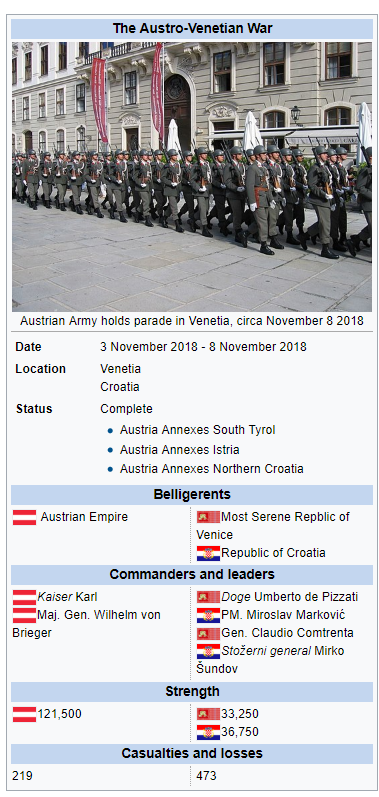HOME | DD
 davoid123 — Austro-Venetian War
davoid123 — Austro-Venetian War

Published: 2018-11-02 08:15:05 +0000 UTC; Views: 1521; Favourites: 19; Downloads: 0
Redirect to original
Description
Part of the Erstwelt AU timeline, specifically one of the few military events to happen in Europe in the year 2018.Background
The first reports of militarization of the Austro-Venetian Border came from the Venetian officials on 20 October, reporting that their neighbor in the Austrian Empire had deployed a number between 2,500 to 50,000 infantry and at least forty Armored units. Venice and Croatia both responded by raising their Military Awareness level, calling for a partial mobilization, and also sending militaries to the border.
The Seigerpakt, a military alliance that Austria was part of, denied any allegations that this was a Seigerpakt operation, while the Entente, of which both Croatia and Venice's were members, failed to respond in any way.
Emboldened by the lack of reaction, the Austrian Empire continued to mobilize its military, also calling for a "Minimal Mobilization" of its 2.5 million reserve, and eventually on 29th of October, the Austrian Chancellor Sebastian von Bellen confirmed Austrian mobilization of its military and cited a claim on Istria and South Tyrol as "Rightful German-Austrian territory", further delivering an ultimatum to the two countries of Croatia and Venetia to cede the claimed territories, giving only 60 hours of time to respond.
In those 60 hours, Chancellor Merkel, president of the Seigerpakt declared that the larger International Alliance would not enter this war on either side as long as no other country would, and Prime Minister May of the Imperial Federation of Britain also declared an Alliance-wide Order of Non-aggression for the members of the Entente regarding the "situation in the Adriatic"
Emboldened by the international apathy in this situation, Austria moved 120,000 troops to the Austro-Venetian and Austro-Croatian borders, and when the two countries failed to respond accordingly by 3 November, declared war on both countries in 9 am (local time), immediately invading both of them.
The War
The First battle of the war occurred on 13 PM in South Tyrol's Stezing, where 40,000 Austrians (supported by Artillery and air force) mowed through the small 20,000 Venetian defense. Outnumbered and outgunned in every turn, the Venetians retreated, and were chased by the Austrians through Meran to Trentino and finally caught them in a battle in Riva. Counting on a 13,000 strong reinforcement that had been ordered to remain in Venice to protect the city, the Venetian force failed to mount a defense, and was overran in Riva two days later.
In 18 PM, Austria also sent another 40,000 to Istria, planning on quick and unhindered occupation, but were stopped by a joint Venetian-Croatian force in the city of Pazin, where 7 Austrian divisions, supported by 10 Heavy and 15 Light Armored battalions, fought off 4 allied regiments. The battle continued for another 3 hours, before the Austrians broke through the allied defenses, and continued their occupation. The 8 Austrian divisions arrived to the coast of Istria by 9 AM of 4 November, having achieved one of their two goals.
As the battle of Riva continued, Austria sent 25,000 divisions to the city of Venice, and another 16,500 to Northern Croatia, while negotiations with the Serbian Principality over movement of Austrian troops began in 5 November. Riva finally fell with minimal casualties (100 Venetians and 35 Austrians), and as the majority of the Venetian troops surrendered, Austria moved 35,000 of its 40,000 from Riva to Venice.
The Battle of Venice, which was the longest battle of the war, started on 5 November and continued for another three days. 70,000 Austrians fought against the small 13,000 men strong Venetian force first outside, and then inside the city limits. Due to a lack of artillery or Air support in this battle -as Austrians had no intention of laying waste to the Venetian city-, Austrians were forced to revert to a more conventional form of combat: brute forcing their way across the city.
The Battle of Zagreb, the capital of Croatia, began on 6 November, but due to the relative weakness of the Croatian defense, it was finished in a matter of days. Austria had already occupied the city by 7 November. Croatia, having lost its capital, surrendered unconditionally on the same day.
Venice fell on 8 November, also leading to the unconditional surrender of the Venetian Republic. The Treaty of Venice was signed the next day, and the war was officially over.
Aftermath
Austria, of course, demanded Istria, Tyrol, Northern Croatia, and also all Venetian territories between Istria and Tyrol in order to have a better control of the Northern Adriatic. They did not, however, demand any reparations due to the short war and lack of any attacks on Austrian territories. The territories were taken as "territories". Tyrol was annexed into The Kingdom of Austria on 29 November. the rest of the territories (Northern Croatia, Istria, and the remaining Italian territories) were annexed into the Duchy of Slovenia on 16 December, which was raised into the Grand Duchy of Slovenia (which was accepted as a secondary member-state of the Austrian Empire, with Kaiser Karl as its sovereign) on 27 December.
Venice, enraged at the apathy of the Entente, left the alliance on 12th of November, and would later fall victim to another attack by Piedmont (at that point, the minor member of a Personal Union with the Frievolker Empire) which led to their full annexation by 12 February 2019. Croatia, having lost its capital, was forced to declare the Montenegrin Podgorica as its new capital. Their substantial loss of power in the war would give Serbia the reason to later invade them, also in the next year, starting the Second Balkan War between Croatia, Serbia, Bulgaria, Greece, and Austria, which resulted in a dramatic change in Balkan politics, and the first war in the Theater of the Two Alliances.























